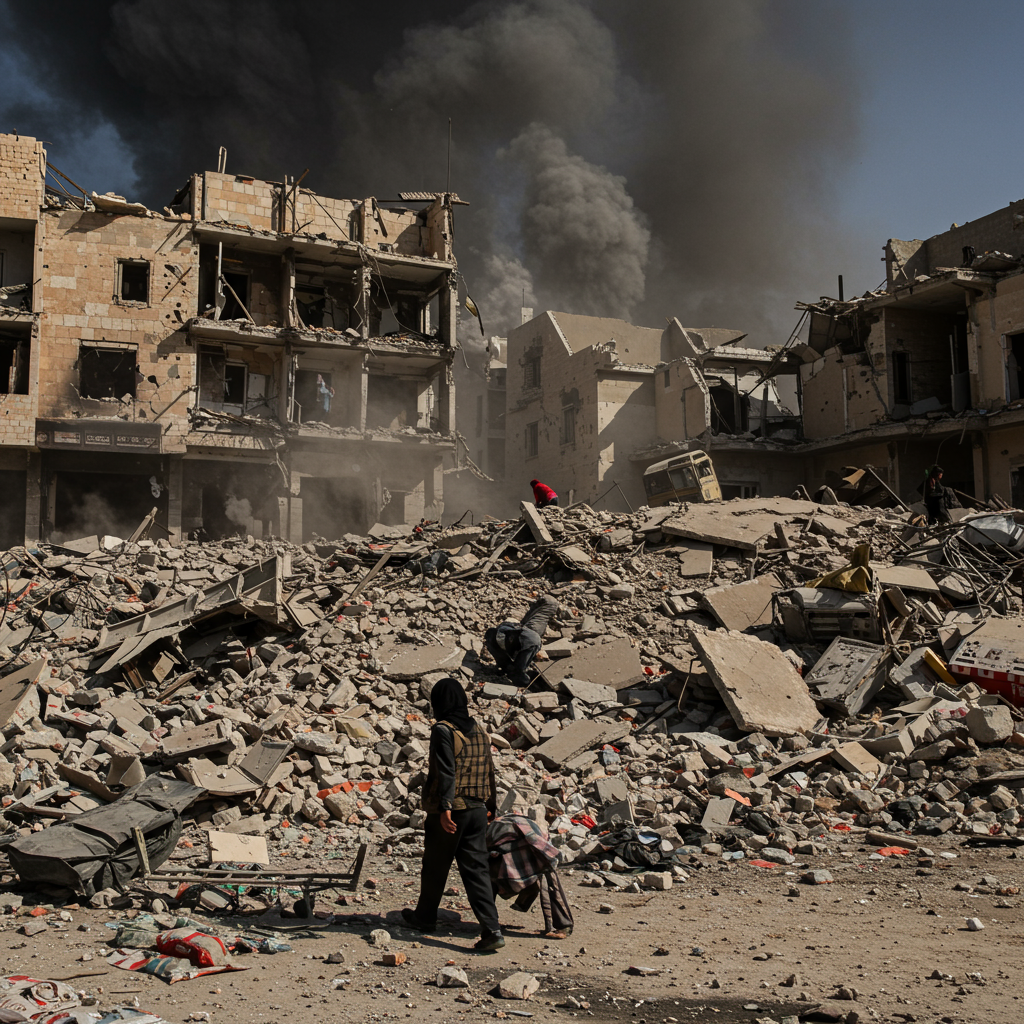Despite recent military strikes targeting its nuclear facilities, Iran retains the core capability to resume enriching uranium to levels potentially suitable for a nuclear bomb within a remarkably short timeframe—possibly just months. This assessment comes from the head of the United Nations’ nuclear watchdog, challenging claims that the strikes achieved total destruction of Iran’s nuclear infrastructure. The situation highlights persistent international concerns over Tehran’s nuclear ambitions and the effectiveness of military action versus diplomatic solutions.
The Watchdog’s Assessment: Capability Remains
Rafael grossi, Director General of the International Atomic Energy Agency (IAEA), offered a sobering perspective on the state of Iran’s nuclear program following strikes by Israel and the United States. Speaking shortly after the attacks, Grossi directly contradicted assertions by figures like former US President Donald Trump that Iran’s nuclear sites were “totally obliterated.” While acknowledging the strikes caused significant damage, Grossi emphasized it was “not total.”
He told CBS News that Iran still possesses the fundamental “industrial and technological capacities.” If Iran decides to proceed, it could potentially have “a few cascades of centrifuges spinning and producing enriched uranium” within a matter of months, or potentially even sooner. This underscores that the knowledge and technical skill accumulated over years cannot be easily erased by physical attacks.
Beyond Physical Damage: Knowledge and Capacity
Grossi pointed out a crucial distinction: damaging facilities does not eliminate Iran’s inherent knowledge base. Iran has developed a sophisticated nuclear program over time. This technical expertise remains intact regardless of the physical state of specific sites. He stressed that the “knowledge is there. The industrial capacity is there.” This enduring capability means Iran could rebuild or adapt relatively quickly if it chooses to.
The Centrifuge Countdown
The specific mention of “cascades of centrifuges spinning” within months provides a concrete, albeit concerning, timeline. Centrifuges are critical machines used to enrich uranium. The number and configuration of these cascades determine the speed and level of enrichment. Grossi’s statement implies that even after facing attacks, Iran retains enough core components or the ability to reconstitute them rapidly to restart enrichment activities to potentially problematic levels.
Conflicting Views on Strike Impact
The assessment from the UN’s nuclear chief stands in stark contrast to the more definitive claims made by some US officials following the strikes. President Trump repeatedly asserted that Iran’s nuclear sites were “completely destroyed” or “totally obliterated.” He described the attacks as a “historically successful” operation, suggesting Iran’s nuclear ambitions were ended “at least for a period of time.” Trump claimed the sites were now just “thousands of tons of rock.”
Operation Midnight Hammer’s Effect
Referred to by some as “Operation Midnight Hammer,” the US strikes joined a campaign reportedly initiated by Israel on June 13. The coordinated attacks targeted three specific Iranian facilities: Fordo, Natanz, and Isfahan. Israel claimed its initial attacks aimed to prevent Iran from developing nuclear weapons. The subsequent US involvement broadened the scope and intensity.
Pentagon and Intelligence Perspectives
Grossi’s view is reportedly supported by other intelligence assessments. A leaked preliminary Pentagon report, described as low-confidence, suggested the US strikes caused “limited” damage and likely only set back Iran’s program by a matter of months, not years or decades. The Washington Post also reported that classified intelligence indicated Iranian officials found the attack less devastating than expected. Similarly, the Tehran Times stated that “the core of Iran’s nuclear program remains operational.” These reports align more closely with Grossi’s cautious assessment than with the US administration’s claims of total destruction.
Iran’s Own Mixed Signals
Adding to the confusion, Iran has presented conflicting accounts of the damage sustained. Supreme Leader Ayatollah Ali Khamenei downplayed the impact, claiming the strikes achieved nothing significant. In contrast, Foreign Minister Abbas Araghchi described the damage as “excessive and serious.” This internal inconsistency makes a definitive public assessment from Tehran challenging.
Strain on Inspections and Diplomacy
The recent hostilities have significantly worsened the already strained relationship between Iran and the IAEA. In the wake of the attacks, Iran’s parliament reportedly moved to suspend cooperation with the international watchdog. Tehran has accused the IAEA of siding with Israel and the US, further eroding trust.
The Challenge of Verification
A critical consequence of this strained relationship is Iran’s refusal to grant the IAEA access to the damaged facilities. Grossi had requested permission to inspect the sites, including the underground Fordo plant. However, Foreign Minister Araghchi publicly criticized Grossi’s insistence, calling it “meaningless and possibly even malign in intent.” This denial of access is a major hurdle for the IAEA, as it prevents inspectors from independently verifying the extent of the damage and the current status of nuclear material and equipment. Grossi emphasized the critical need for inspections to “confirm what is there, where it is, and what happened.”
Hope for a Diplomatic Path
Despite the current non-cooperation, Grossi maintained that a long-term solution must ultimately be diplomatic. He expressed hope for resuming negotiations with Tehran to find a “technically sound solution.” The IAEA’s core function is verification through inspection, which requires cooperation from member states. Grossi believes that given Iran’s undeniable nuclear knowledge and capacity, a verifiable agreement remains the most viable path forward. He argued that Iran’s sophistication in nuclear technology should incentivize reaching an agreement that includes a robust inspection system to provide international assurances.
The Uranium Stockpile Question
A significant concern highlighted by the IAEA chief is the fate of Iran’s existing stockpile of highly enriched uranium (HEU). Before the strikes, the IAEA had reported that Iran held over 400 kilograms (nearly 900 pounds) of uranium enriched to 60% purity. This level is alarmingly close to weapons-grade (around 90%). Theoretically, if further refined, this stockpile could potentially yield enough material for multiple nuclear bombs – some estimates suggest up to nine.
Highly Enriched Uranium: A Critical Concern
The presence of a substantial amount of 60% enriched uranium represents a significant proliferation risk. Enriching uranium from natural levels (below 1%) to 60% is the most technically challenging and time-consuming step in creating weapons-grade material. Possessing such a large quantity bypasses much of this effort, drastically reducing the time needed for a potential “breakout” to bomb-grade fuel.
Where Did the Stockpile Go?
Grossi acknowledged that the IAEA is currently uncertain whether this critical stockpile was destroyed during the attacks or potentially moved to a secret offsite location beforehand. He stated clearly, “There has to be, at some point, a clarification.” President Trump expressed skepticism about the feasibility of moving such a heavy and hazardous material undetected, suggesting it was unlikely. However, without access for verification, the international community cannot definitively confirm the status or location of this highly concerning material.
Geopolitical Fallout and Ceasefire Dynamics
Following the intense period of strikes, a ceasefire has reportedly been agreed upon between Iran and Israel. However, the underlying tensions remain high, and the agreement appears fragile.
Fragile Ceasefire, Lingering Tensions
Iran’s armed forces chief of staff, Abdolrahim Mousavi, publicly expressed serious doubts about Israel’s commitment to abiding by the ceasefire. He stated that while Iran did not initiate the conflict, it responded forcefully to aggression and remained ready to use force again if attacked. This suggests a climate of deep mistrust persists despite the formal agreement to halt hostilities.
Future Military Options Remain
Adding to the instability, President Trump indicated he would “absolutely” consider further military action against Iran if intelligence suggested the country was enriching uranium to concerning levels. This potential for renewed strikes, coupled with Iran’s stated readiness to respond, leaves the region in a precarious state, with the risk of escalation ever-present.
Historical Context: The Nuclear Deal’s Collapse
Understanding the current situation requires recalling the history of the 2015 nuclear deal, formally known as the Joint Comprehensive Plan of Action (JCPOA). This agreement, struck between Iran and world powers, significantly curtailed Iran’s nuclear activities in exchange for sanctions relief.
From Agreement to Escalation
Under the JCPOA, Iran was strictly limited in its enrichment activities, including a cap on enrichment purity at 3.67% (suitable for civilian power plants) and a prohibition on enriching uranium at the Fordo facility for 15 years. However, the agreement began to unravel when the United States, under the Trump administration, unilaterally withdrew in 2018. Washington argued the deal did not go far enough to prevent Iran from eventually obtaining nuclear weapons and did not address other concerns like ballistic missiles or regional influence.
Key Provisions and Breaches
Following the US withdrawal and reinstatement of sanctions, Iran began progressively breaching the deal’s restrictions. These breaches included enriching uranium to higher purities (up to 60%) and resuming enrichment activities at Fordo in 2021. These steps significantly shortened the theoretical time required for Iran to produce bomb-grade material, contributing directly to the international alarm that preceded the recent strikes. Iran continues to maintain that its nuclear program is solely for peaceful civilian purposes, despite these escalatory steps.
Human Cost and Related Incidents
While the primary focus remains on nuclear capabilities, the recent conflict also resulted in human casualties. According to reports from the Iranian Ministry of Health, at least 627 civilians were killed in Iran during the 12-day assault. Israeli authorities reported 28 people killed in Israel due to retaliatory strikes from Iran.
One specific incident reported by Iran’s judiciary was an Israeli missile strike on Tehran’s Evin Prison on June 23. This attack allegedly killed 71 people, including prisoners and visitors. Al Jazeera reported that Iranians believed this strike might have aimed to free certain prisoners, characterizing the bombing of a civilian facility as unacceptable. Evin Prison, housing various detainees including political prisoners, has faced sanctions from the US and EU over human rights concerns. These tragic events underscore the broader human impact of the escalating tensions.
Frequently Asked Questions
What did the head of the IAEA say about Iran’s ability to enrich uranium after the strikes?
Rafael Grossi, the IAEA Director General, stated that despite recent strikes, Iran retains the industrial and technological capability to resume enriching uranium for a potential bomb within “a matter of months” or less. He contradicted claims of total destruction, emphasizing that while damage was severe, it wasn’t total, and Iran’s knowledge base persists.
What is the significance of Iran’s 60% enriched uranium stockpile mentioned in the article?
The 60% enriched uranium stockpile is highly significant because it is very close to weapons-grade (around 90%). Possessing this material drastically reduces the time needed to produce fuel for a nuclear bomb. The IAEA is currently uncertain if this stockpile was destroyed during the strikes or moved, raising major proliferation concerns that require urgent clarification.
What are the next steps for international diplomacy regarding Iran’s nuclear program?
Despite the current lack of cooperation and Iran’s refusal to grant inspectors access, the IAEA Director General, Rafael Grossi, believes that a long-lasting solution must be diplomatic. He expressed hope for resuming negotiations with Iran to find a “technically sound solution” that includes a verifiable inspection system to provide international assurances about the program’s nature.
Conclusion
The assessment from the head of the UN’s nuclear watchdog paints a complex picture: while recent military strikes have undoubtedly impacted Iran’s nuclear facilities, they have not eliminated the fundamental capacity for uranium enrichment. The enduring knowledge base, coupled with concerns over the unaccounted-for stockpile of highly enriched uranium, means Iran could potentially move towards bomb-relevant enrichment levels relatively quickly if it chooses. The strained relationship with the IAEA, marked by denied access for inspectors, further complicates international efforts to monitor the program. Amidst a fragile ceasefire and lingering threats of further military action, the path forward appears reliant on overcoming significant mistrust to find a verifiable, diplomatic solution to prevent further nuclear escalation.
Word Count Check: ~1150 words



